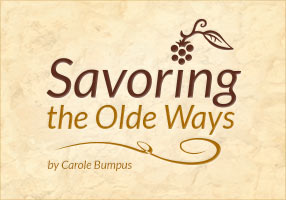Les Cailles à Hydringus et Zinziberine
(Quail with Hydringus root and Fresh ginger)
Carole Bumpus
“We are now ready to fully engage in the serious business of ancient and medieval cuisine,” Madeleine Vedel began. Our Provençal culinary tour group huddled around Madeleine and her chef husband, Erick, as she translated his every move. We were standing in their kitchen, which was purported to have once been a first century, A.D., Roman stable.
“Arles is situated on the Rhône River and is one of the first ports-of-call on the inland ‘highway’ into France from the Mediterranean.” We all nodded our heads vigorously, put down our wine glasses and took up our pens.
“Long before France was named Gaul by the Romans,” she continued in hushed tones, “commerce flowed through our ancient city. You see, food and recipes have always transcended the need for a common language and as mariners stopped at our port, they shared recipes and spices from their homelands. Tonight you will experience some of these ancient recipes.” My heart skipped a beat and I began writing with a frenzy.
“Our first recipe is called ‘Paquets d’Aubergine, or Eggplant Packets; the second is Le Tian Provençal, a mélange of succulent summer vegetables. But the third recipe is most unique. It’s called Les Cailles à’Hydringus et Zinziberine,” she purred, drawing the words out dramatically. We nodded our heads appreciatively, having no earthly idea what she had just said.
“Ah, this is quail with hydringus root and fresh ginger. The recipe uses the medieval method of double-cooking meat and game twice. First, the quail is poached in broth and then, deep-fried in lard. The little birds are then served with a relish, or confiture, first noted by Nostradamus in the 16th century. He lived only a few short miles from us in St. Remy,” she said in an off-hand sort of way. “His sauce is an example of sweet and spicy flavors blended together.”
“Zinziberine,” she continued, “is the medieval word for ginger while Hydringus is the medieval name given to a rare root vegetable known in Provençe as ‘panicaut’. I believe it is from the artichoke family, but Erick chooses to use carrots instead.” We all looked up in surprise as she casually shrugged her shoulders. “The flavors work well and the produce is readily available.” It worked for us.
During the following steamy hours of observation, my imagination took wing. I could envision those boatmen from a millennium ago and the entire seamy, yet savory scene: olive-skinned men wearing filthy blousons and pantaloons with brightly-colored scarves wrapped about dark heads; sweat-soaked faces working over a steaming cauldron while a concertina played and men laughed raucously around a roaring fire. And, I swear I could hear the sound of knives whacking at meats and vegetables, while greasy hands sprinkled exotic spices over the finished product. I was enchanted.
Finally, it was our turn to cook. I chose to work on the Cailles. I began by wrapping my hands around those lovely little quail just to experience what others had done before me. I ignored the titters of laughter and the lively banter around me and concentrated on the task at hand. Swiping at a flopping tendril, I leaned my sweat-soaked face over the simmering broth and dropped in the featherless carcass. Scooping it out of the broth, I dried the drooping creatures, quickly dusted them with corn starch and immersed them into boiling oil. Voilà! I had found my new passion: preparing recipes from ages past.
When our cooking lessons were complete, dinner was served. Succulent aromas of olive-oil laced vegetables filled the air, as cheese-encrusted tians of Aubergine Paquets sizzled in our midst. Then, the pièce de résistance, Les Cailles à l’Hyringus et Zinziberine, was placed in the center of the table. There, staring up at us were fifteen pairs of eyes from the displayed—or splayed—golden-brown bodies of the quail. Some of my cohorts withdrew from the prospect of eating the ‘little birds,’ but I found the quail quite delectable. All were consumed, including the crunchy little heads. And, why not? Where else could we experience delicious and sumptuous recipes shared from hundreds of years ago? Ah, and just a touch more Provençal rosé from the Côte de Rhône, s’il vous plaît.
Tour conducted at the home of: Erick and Madeleine Vedel
of the Association et Cuisine et Tradition
Arles, France
May 1st, 2000

Leave a Reply